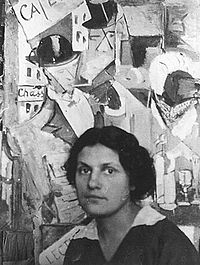- Nadezhda Udaltsova
-
Nadezhda Andreeva Udaltsova (Russian: Наде́жда Андре́евна Удальцо́ва 1886 - 1961) was a Russian avant-garde artist (Cubist, Suprematist) and painter.
Biography
Nadezhda Udaltsova was born in town Orel in Russia. Udaltsova studied at private art studios in Moscow, then in Paris under André Segonzac.
After returning to Russia, she worked in Vladimir Tatlin's studio. From 1910 to 1914 she was a member of the union of artists Soyuz Molodyozhi, together with David Burliuk, Vladimir Burliuk, Pavel Filonov, Kazimir Malevich, Ivan Kliun et al.
In 1915, she joined the movement of Kazimir Malevich's followers Supremus, and in 1915-1916, together with other suprematist artists (Kazimir Malevich, Aleksandra Ekster, Liubov Popova, Nina Genke, Olga Rozanova, Ivan Kliun, Ivan Puni, Ksenia Boguslavskaya and others) worked at the Verbovka Village Folk Centre.
After the October Revolution she taught at VKhuTeMas and Institute for Artistic Culture (InKhuK). She resigned from InKhuK in opposition to plans for replacing easel painting with industrial art.
In the 1920s, under the influence of her husband and notable Russian avant-garde painter, Alexander Drevin, she returned to the figurative art.
Udaltsova and Drevin were the founding members of the artistic group Thirteen.
In 1929-1932 they traveled to the Altay Mountains, then in 1933-1935 they worked in Armenia. In 1938 Alexander Drevin was arrested and executed by the NKVD, and Udaltsova became a persona non grata in the world of Soviet art. She died in 1961 in Moscow.
Udaltsova crater on Venus is named after her. Her son was the prominent Russian sculptor Andrei Drevin (1921-1996).
Categories:- 1886 births
- 1961 deaths
- People from Oryol
- Russian painters
- Soviet painters
- Russian avant-garde
- Modern painters
- Cubist artists
- Russian women artists
- Faculty of Vkhutemas
Wikimedia Foundation. 2010.

